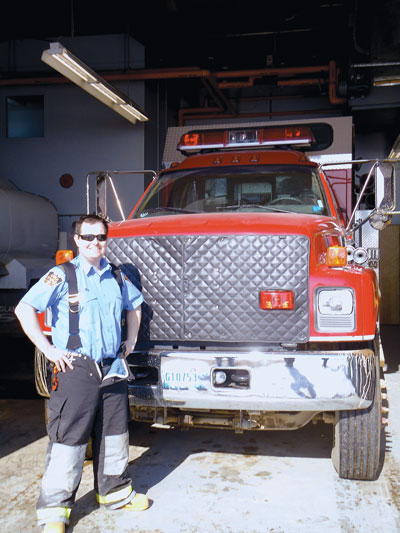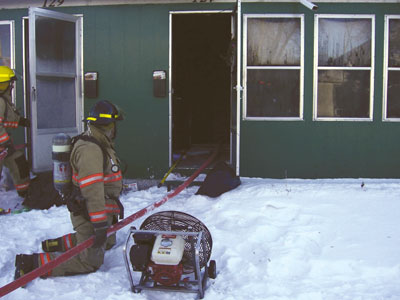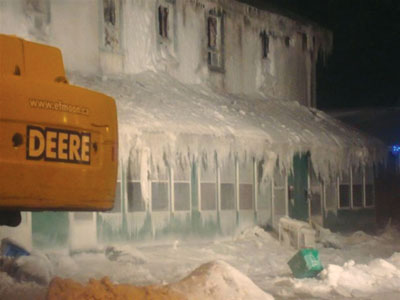
Features
Training
Fire and ice
All firefighters loathe fighting structure fires in cold temperatures but those who make their homes in the Arctic Circle are particularly proficient at dealing with the effects of extreme weather on the job.
December 28, 2012
By Kirk Hughes
All firefighters loathe fighting structure fires in cold temperatures but those who make their homes in the Arctic Circle are particularly proficient at dealing with the effects of extreme weather on the job.
 |
|
| Assistant Chief Kirk Hughes stands in front of a truck with a winter grill – a coat for the truck to keep the engine heat inside. Photos by Kirk Hughes |
Gear preparation is vital to successfully combating fire in cold weather. A cold firefighter exhausts more quickly, and rapidly becomes ineffective when the temperature bottoms out. To limit the effects of cold temperatures on firefighters bodies, most northern firefighters reinforce their gear with items that will retain body heat, and they wear items that can be easily replaced when they become wet or cold.
A thicker balaclava should be used by a firefighter actively engaged in fire suppression, coupled with a Nomex neck gaiter for extra thermal protection.
When not involved in firefighting operations, a firefighter should switch to a heavy knit toque, which should be long enough to cover the neck and ears without obstructing hearing. A good toque can easily be worn under an adjustable helmet with a quick turn of the ratchet. Extra balaclavas can easily be carried in a pocket or in a small gym bag that also can be used to carry extra socks, flashlight batteries, snowmobile mitts, toques and sweaters.
Underneath the bunker jacket, firefighters operating in low temperatures for extended periods should wear a heavy-gauge work sweater, preferably over a moisture-wicking fabric base layer. The ability to move sweat away from the skin helps to keep firefighters dry and warm. Bunker pants are hard to prep, but purchasing long thermal underwear a few sizes larger than normal and lining them inside the pants is an excellent way to provide another thermal layer without having to remove any articles of clothing that may slow down your response time.
The extremities are the first indicator that a firefighter is being affected by the cold. When donning flame-resistant gloves, start by putting on a thinner, insulated neoprene utility glove that will keep body heat closer to the fingers and palm, and will provide another barrier to prevent the cold and wetness from contacting the skin. Nothing is better for keeping hands warm than firefighter mitts, a staple for Arctic firefighters, so if possible, invest in them.
 |
|
| A firefighter completes horizontal ventilation in a cold climate.
|
Feet stuck in hardened and reinforced rubber boots are bound to become ice in no time when walking in snow, sweating from work and trudging through ice, slush and puddles on the fire ground. A good, thick pair of work socks is a must, and a comfortable, shock-absorbing contoured insole is a worthy investment. These two items prevent heat loss when in contact with the ground.
A properly dressed firefighter is not useful if the truck isn’t acclimatized for winter work. Department operating procedures should be adopted regarding wet and dry tanks, draining of valves and vehicle maintenance. Radiator heat shields should be checked regularly to ensure that they are fastened properly. When on scene at any incident, keep the pump circulating water at all times and place the pump heater on its highest setting. In environments in which extreme weather lingers for months at a time, it is advisable to coat truck and hoseline threads with anti-freeze to assist with breakdown. Pack a few towels in the pump panel to be placed on top of hose connections to prevent the formation of ice around vital foot-traffic areas.
Arriving on scene, an incident commander should be wary of additional risk factors associated with winter-weather operations. Of particular note should be ice and snow accumulation on load-bearing platforms, such as roofs, which could increase the potential for building collapse and hamper rescue operations. If ventilation crews cannot access the roof because of these increased dangers, horizontal ventilation should be considered. Homeowners often seal their homes up in the colder months, so the possibility of backdraft exists. All firefighters should be reminded of the signs of this fire condition.
Be mindful of escalating firefighter fatigue and the onset of frostbite or hypothermia. Rehabilitate and rotate fire crews often, and use medical sectors to monitor firefighters’ health and safety. Firefighters in rehab should be encouraged to eat and drink to keep their internal furnaces going and to replace body fluids lost during physical exertion.

|
|
| This structure has extensive ice buildup, which prevents ventilation and increases the risk of structural collapse.
|
During rehab, firefighters should double-check SCBA, especially for regulator freeze-up and facepiece failure. Ideally, SCBA should be placed away from the elements as much as possible, even if they are simply covered up with a wool blanket.
Fire gear such as coats and helmets should be hung up outside and not brought into warm areas where they could thaw and soak through, causing them to re-freeze when that firefighter is moved back to fire-ground operations. Ideally, firefighters covered in ice should transition to another set of bunker gear, but not all departments can afford such a luxury. At the very least, firefighters should shake off excess ice and snow from their gear with a brush as often as tactics permit, especially prior to entering rehab. All firefighters should be encouraged to change wet socks, gloves and balaclavas often to maintain dexterity and prevent freezing.
Setting up the fire ground is an essential factor for firefighter safety. Time should be taken during large, extended operations to create pathways by shovelling away snow and slush, and spreading sand to prevent accidents. Some departments swear by the creation of snow shelves dug into snow banks and covered with a high-visibility tarp. These snow shelves are then used as staging areas for items. This thwarts missing and lost tools and speeds up equipment access. Using pylons to mark staging areas provides ease of recovery and circumvents buried hoselines. Hoseline nozzles not in operation should be left flowing to prevent them from icing over; if possible, nozzles should be placed near the exhaust of a truck to keep them defrosted. Hoselines that are immediately drained after application or are left uncharged until needed, can be quickly placed back into service without fear of ice blocks or obstructions. Firefighters should make it a habit to check charged hoselines and to move them around in cold weather to prevent dreaded freeze-up.
Arctic fire fighting is a unique vocation; however, cold-weather firefighting in winter months affects all Canadian fire departments. These tips were gained through experience by firefighters working in one of the world’s harshest, most demanding and most unforgiving environments. Take the time to prepare for the winter so that your department won’t be left out in the cold.

|
|
Kirk Hughes is the assistant fire chief of special operations for the Déline Fire Department and a local assistant to the fire marshal of the Northwest Territories. Hughes is a graduate of Dalhousie University’s fire-service leadership program and is the 2011 winner of the NWT Fire Service Merit Award. He has worked for Emergency Management Ontario, and as a firefighter in Portage la Prairie, Man., and Burlington/Kilbride, Ont., and at Ball Industries. Prior to arriving in the Northwest Territories, Hughes served as the RCMP emergency-services co-ordinator for the G8 Summit. Contact him at khughes@firehousemail.com
Print this page